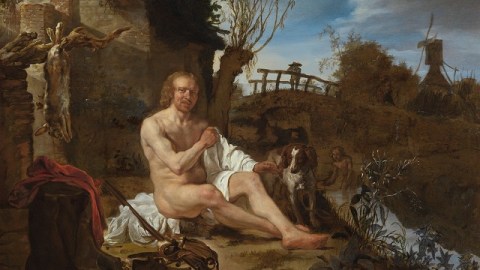Gabriel Metsu: Close, But No Vermeer

“Why buy a Vermeer when a Metsu is available?” Adriaan E. Waiboer, curator of northern European art at the National Gallery of Ireland, repeats that odd sounding question in the catalog to Gabriel Metsu, 1629-1667, which runs at the National Gallery of Art in Washington, DC, through July 24, 2011. That question didn’t sound so odd in the early 19th century, when Metsu’s reputation stayed strong while Vermeer remained a little-known quantity. In this exhibition of Metsu’s art, the first worldwide since 1966 and the first ever in the United States, Americans get a glimpse of a contemporary and rival of Vermeer, who seems so unique in the public’s imagination. Perhaps you’ll come away, as I did, thinking along the lines of the old carnival barker’s line, “Close, but no cigar.” Yes, Gabriel Metsu’s “Close, but no Vermeer,” but that’s not necessarily a bad thing.
A prodigy, young Gabriel earned the name of “painter” as early as 14 years of age in his hometown of Leiden, where he painted mainly large, bold religious scenes and may have studied with Gerrit Dou. A decade later, Metsu moved to Amsterdam, where he encountered a wider range of influences, including Vermeer, Rembrandt, Gerard ter Borch, and Jan Steen. Vermeer, who was actually 3 years younger than Metsu, may have been influenced by Metsu as much as he influenced Metsu with that dazzling technique so familiar to us today. But, as E. Melanie Gifford explains in the catalog in an essay on Metsu’s technique, effects such as the classic Vermeer use of dots to indicate highlights reappear in Metsu’s paintings as “recognizable quotations of Vermeer’s manner.” But, as Vermeer and others sought a “painterless” style with no visible brushstrokes, Metsu imitated that style but still allowed his painterly personality to shine. “Resist[ing] the fashion for a smooth surface that suppressed evidence of the artist’s presence,” Gifford writes, “Metsu’s eloquently imprecise technique conjured ‘wool and silk and silver’ while celebrating the act of painting.”
Excelling in portraiture, genre paintings, and even religious works, Metsu could do it all, seemingly in any style. Praising “Metsu’s extraordinary flexibility in blending different subjects, styles and techniques,” Waiboer argues that Metsu “was such a diverse and adaptable artist that his oeuvre reflects almost the entire scope of Dutch genre painting of the middle of the seventeenth century.” This exhibition does its best to portray Metsu as a “one-man show” of the Dutch Golden Age of painting, which is amazing considering that the show consists of only 33 paintings, 14 of which have never been seen in the United States.
But Metsu’s more than just a talented chameleon. In A Hunter Getting Dressed after Bathing (shown above), Metsu painted himself as a nobleman, the class to which hunters belonged, but adds the twist of a full-length, unidealized, naturalistic nude. There’s nothing like it in the painting of the period. Metsu signed his name on the stock of the gun just to make sure that viewers made the connection. Although he frequently inserted self-portraits into his paintings, including one in full painter’s garb and another as the prodigal son, Metsu boldly went where no other painter of his time went before. One wonders where Metsu, who died at the young age of 37, would have taken his talents given more time.
In the 1860s, Vermeer began to rise in the estimation of art critics, and Metsu began to fall in comparison. “Such assessments would have been unimaginable in the eighteenth and early nineteenth centuries,” Waiboer concludes, “and are due to the increasing glorification of the Delft artist at the cost of his contemporaries.” Gabriel Metsu, 1629-1667 strikes a blow for all the forgotten artists whose paintings haven’t inspired novels and movies but who deserve to be remembered not only on their own merits, but also for their contributions to making Vermeer who he was. Gabriel Metsu was no Vermeer, but Vermeer, in turn, was no Gabriel Metsu. Metsu’s short life raises obvious questions of what could have been, but Metsu’s achievements at the same time Vermeer created his masterpieces raise other, even more fascinating questions of what he, too, could have done differently.
[Image:Gabriel Metsu. A Hunter Getting Dressed after Bathing, c. 1654-1656. Oil on panel, unframed: 52.1 x 63 cm (20 1/16 x 24 13/16 in.). Private collection, New York. © IGRAT 2006 LLC.]
[Many thanks to the National Gallery of Art in Washington, DC, for providing me with the image above from, press materials for, and the catalog to Gabriel Metsu, 1629-1667, which runs through July 24, 2011.]





